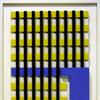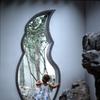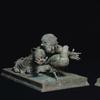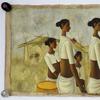Social Issues Spotlighted in First-Ever Suzanne Lacy Retrospective at SFMOMA and YBCA
- SAN FRANCISCO, California
- /
- November 15, 2018
Throughout her prolific career, Los Angeles–based artist Suzanne Lacy has used community organizing strategies and media interventions to create dialogue-based performances about pressing social issues, including feminism, violence against women, racism, and labor rights. A pioneer of social practice—a field that she has helped define through her performances and art installations, writings, and teachings—she organizes public encounters that combine intensive dialogue and collaborative choreography.
Suzanne Lacy: We Are Here, co-organized by Yerba Buena Center for the Arts (YBCA) and the San Francisco Museum of Modern Art (SFMOMA), is the first full retrospective of the artist’s career. It is conceived as one exhibition at two venues.
At SFMOMA, Suzanne Lacy: We Are Hereexplores nearly five decades of the artist’swork, from her earliest performances, objects, and photographs in the 1970s to her latest immersive video installations. YBCA’s presentation updates Lacy’s key collaborative projects from the 1990s, including an in-depth revisiting of The Oakland Projects (1991–2001), a series on youth representation, media education, and policy; the show includes new works by Bay Area youth-centered organizations and artists.
Jointly curated by SFMOMA Curator of Media Arts Rudolf Frieling, YBCA CuratoratLarge Lucía Sanromán, and Director of the Institute for Contemporary Art at Virginia Commonwealth University and former Curator of Education and Public Practice at SFMOMA Dominic Willsdon,Suzanne Lacy: We Are Here will be on view at YBCA and SFMOMA April 20 through August 4, 2019.
“Fittingly co-organized by a renowned museum and civicallyfocused arts center, this retrospective of Lacy’s work aims to continue YBCA’s commitment to public life, complemented by the rigorous review of a fifty-year career that the partnership with SFMOMA makes possible,” remarks Sanromán. “We are also exploring the social and political legacy of Lacy’s work, particularly as it relates to the current context of youth, feminist, and labor issues in the Bay Area.”
“Reflecting three years of research and close work with the artist, the exhibition addresses participation and the relationship between sociallyengaged practice and public life from a variety of perspectives and approaches,” says Frieling. “Acknowledging the importance of social practice for the history of contemporary art is overdue.”
YBCA Presentation
For its presentation, YBCA departs from the traditional retrospective format, proposing instead an experimental approach to authorship and participation inspired by Lacy’s own commitment to collaborative creation. The Oakland Projects (1991–2001) and La piel de la memoria / Skin of Memory (1999) are presented at YBCA as a point of entry into youth culture and activism in the Bay Area from the 1990s to today. Both are long-term projects and performances where Lacy and her many collaborators worked with government, education, and social service agencies to engage with youth and address the structural stresses inherent in urban spaces. The Oakland Projects was a series of educational programs and performances that gave young people of color tools to create their own media images that countered the negative representations of youth prevalent in the media in the 1990s. La piel de la memoria / Skin of Memory took place in Medellín, Colombia, and contributed to the creation of a civic process to address systems of violence and trauma.
For Suzanne Lacy: We Are Here, the artist has invited former participants in The Oakland Projects to reflect on their processes and relationships and consider how to represent their work more than eighteen years after the project’s conclusion. Central to the YBCA presentation is the inclusion of three local youth arts and activist organizations: San Francisco–based Youth Speaks, Berkeley-founded Youth Radio, and Oakland-based Center for Media Justice. Alongside contemporary Bay Area artists currently working with youth, these collaborators will create new works that reflect on the urgent issues affecting young people today, including the influence of social media, restorative justice, and the consequences of the Bay Area’s accelerated gentrification.
“The Oakland Projects was specifically focused on youth, education, government, and health practices and policies in relation to communities of color,” explains Sanromán. “We want to feature today’s youth work and make present the projects of these organizations that are concerned with equity.”
SFMOMA Presentation
At SFMOMA, the retrospective encompasses the diverse range of mediums that Lacy has explored throughout her career, including performance, photography, film, sculpture, video installation, drawing, artist’s books, and ephemera. It features approximately seventy solo and collaborative works, from Lacy’s earliest projects in the 1970s to her latest video installations, including the world premiere of De tu puño y letra (By Your Own Hand, 2015/2019), which draws from letters written by Ecuadorian women about their experiences of violence, and the US debut of The Circle and the Square (2016), which explores the racial consequences of globalized capitalism in England.
“It’s striking how the topics that Lacy has been working on for decades—immigration, race and policing, working-class culture, gender—are still very front of mind for many artists working today,” remarks Frieling.
“This exhibition highlights some of the ways in which Lacy has made projects—particularly since around 2000—that rethink past ideas, either for aesthetic or political reasons, which has become an important part of her practice in the last couple of decades,” adds Willsdon.
Lacy’s ethically committed, participatory performances and large-scale projects have blurred the line between life and art. Several works on view at SFMOMA honor the voices and contributions of women to public life, and embody Lacy’s role as a pioneer of feminist art practice since the early 1970s. Her best-known performances convening groups of women, such as Three Weeks in May(1977), In Mourning and in Rage (1977, with Leslie Labowitz), and The Crystal Quilt (1987), are represented through videos, photographs, and sculptural elements. Attesting to the artist’s lasting relationship with the Bay Area, several coauthored works on view were originally staged in San Francisco, including Alterations (1994), Freeze Frame: Room for Living Room (1982), and International Dinner Party (1979). The installation Alterations and the performance Cleaning Conditions (2013) address issues of labor and will be activated at SFMOMA with new local participants, in addition to public programs with a focus on feminism and youth.
PUBLICATION
Suzanne Lacy: We Are Here is accompanied by a 288-page catalogue featuring approximately four hundred illustrations; curatorial essays by Rudolf Frieling, Lucía Sanromán, and Dominic Willsdon; contributions by Jessica D. Brier, Christa Cesario, Lucia Fabio, Taylor Shoolery, and Tanya Zimbardo; and new and archival commentary on Lacy’s work by peers and collaborators. The catalogue is coedited by Frieling, Sanromán, and Willsdon, and published by the San Francisco Museum of Modern Art in association with DelMonico Books • Prestel.


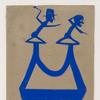



100x100_c.jpg)

